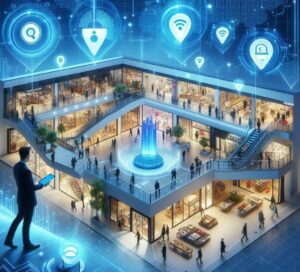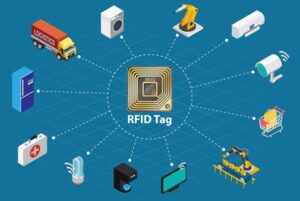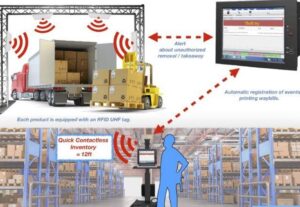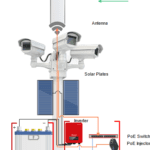In the competitive retail landscape, technologies like RFID (Radio-Frequency Identification) and IoT (Internet of Things), including BLE (Bluetooth Low Energy) beacons, are reshaping the management of shopping malls. These innovations enable efficient data capture, enhance security, and significantly improve customer interactions.
The Evolution of Shopping Malls
Shopping malls have evolved from simple retail spaces into complex ecosystems that draw diverse visitors. Today, malls are not just places for shopping; they offer dining, entertainment, and social interaction. Initially, malls were suburban constructs with limited access. Over the years, developers have shifted focus to create engaging environments featuring modern food courts, experiential retail, and entertainment options. This evolution has paved the way for the integration of advanced technologies.
The Smart Shopping Mall Concept
The smart shopping mall concept leverages IoT devices and sensors to create interconnected environments that enhance security, operational efficiency, and customer experience. 
Key Features of a Smart Mall
Smart Access Control: RFID systems manage entry and exit points, ensuring secure access to restricted areas.
Dynamic Lighting and Climate Control: IoT sensors adjust lighting and HVAC systems based on real-time occupancy data, optimising energy consumption.
Air Quality Monitoring: Continuous air quality monitoring ensures a healthy environment for shoppers and staff.
Mobile Applications: Integrated apps provide navigation, gamification, and personalised promotions, enhancing the shopping experience.
Technical Applications of RFID in Shopping Malls
RFID technology offers a range of applications that optimise operations and improve customer engagement:
Attendance Management
RFID badges streamline attendance tracking for employees. By equipping staff with RFID-enabled badges, managers can automate check-ins and check-outs at entry points through RFID scanners. This system reduces human error in tracking attendance.
Provides real-time data on employee presence and absenteeism.
Allows managers to analyse attendance patterns for staffing optimisation.
Trolley and Cart Tracking
RFID can be applied to manage and monitor the location and availability of shopping carts and shopping trolleys efficiently. By embedding RFID tags in trolleys, malls can achieve real-time tracking of trolley locations throughout the mall—automated alerts for misplaced or abandoned trolleys—and data analytics on trolley usage patterns to optimise trolley distribution.
Inventory Management
Implementing RFID for inventory management allows for real-time tracking of products. Each item can be tagged with an RFID label, facilitating automated inventory counts and reducing the need for manual inventory. Enhanced visibility into stock levels, Automatically alerts staff when stock levels reach a predefined threshold, streamlining replenishment processes. Integration with inventory management systems for streamlined operations. Fixed readers can be installed at strategic locations (e.g., entry/exit points, storage areas) to capture data from RFID tags as products move.
Loss Prevention
RFID technology can significantly enhance loss-prevention strategies in shopping malls
Anti-Theft Systems: RFID tags can trigger alarms when items are removed from the store without proper checkout.
Exit Monitoring: RFID readers at exit points monitor tagged items, alerting security personnel of potential theft.
Data Analytics: Provides insights into theft patterns, helping to develop better security strategies
Leveraging IoT Technologies in Shopping Malls
The integration of IoT (Internet of Things) technologies in shopping malls is transforming the retail landscape, enhancing operational efficiency, and improving customer experiences. By utilising interconnected devices and data analytics, malls can create smarter environments and receive information about available spots via mobile apps, reducing congestion and wait times.
Indoor Navigation Systems
Using BLE (Bluetooth Low Energy) beacons and mobile apps, malls can send location-based promotions and notifications to shoppers’ smartphones. This technology allows shoppers to find their way to stores, restrooms, and other amenities easily through dynamic maps and turn-by-turn navigation via mobile applications, enhancing the shopping experience. As customers navigate, malls can send location-based offers and promotions directly to their devices.
Proximity Marketing
BLE beacons can deliver personalised marketing messages to shoppers’ smartphones based on their location within the mall.
Analyse customer engagement metrics to refine marketing strategies.
Build loyalty programmes that respond to individual shopping behaviours.
NFC for Parking Payments
NFC technology simplifies the payment process for parking. By installing NFC-enabled systems, malls can offer:
Contactless payment options through smartphones or NFC cards reduce congestion at payment points.
Integration with mobile apps for easy payment processing.
Enhanced security and convenience for users in a cashless environment.
CCTV Surveillance for Security
CCTV systems enhance security within shopping malls. By strategically placing cameras, malls can:
Monitor high-traffic areas in real-time, deterring criminal activity.
Utilise video analytics for identifying suspicious behaviour.
Ensure rapid response to incidents through integrated security management systems.
Conclusion
Integrating RFID and IoT technologies is essential for modernising shopping mall management and enhancing customer experiences. By using RFID for attendance and inventory, along with IoT solutions like BLE for proximity marketing and NFC for payments, malls can boost efficiency and create personalised experiences that drive customer loyalty.




